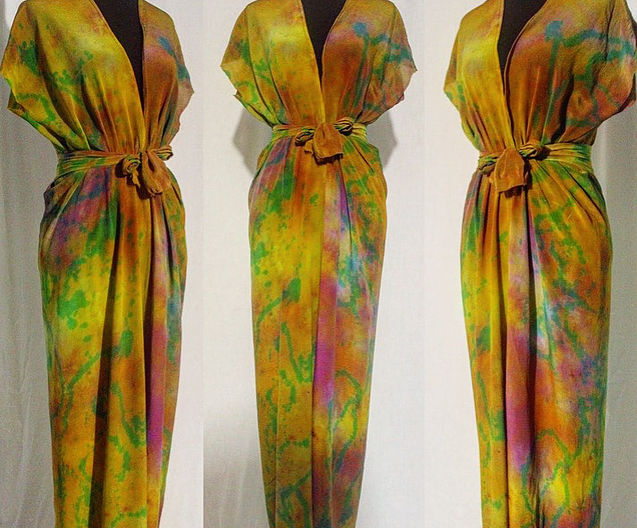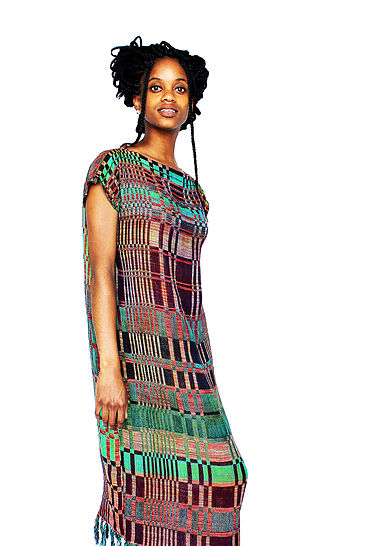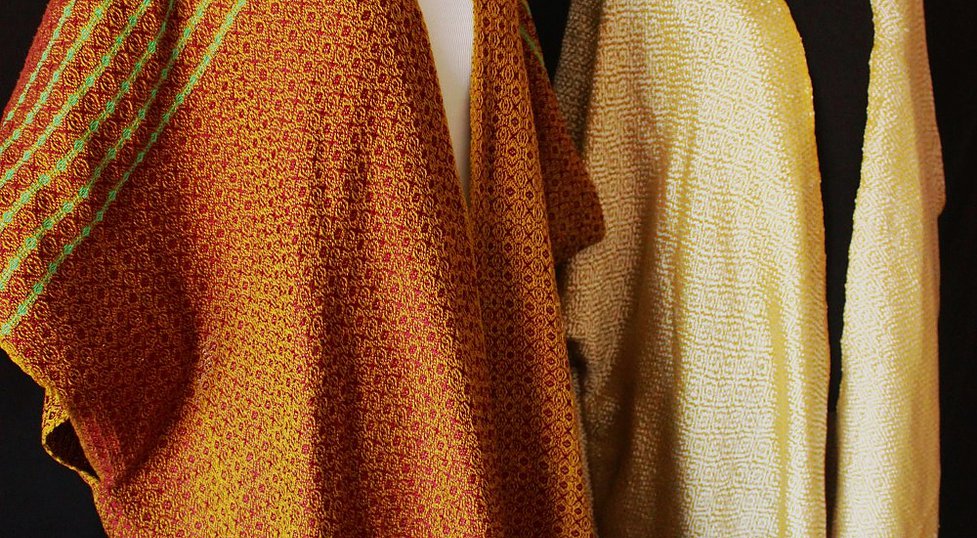Teaching, Textiles, and Time: Simone Evans
A few weeks ago, I had the opportunity to sit down with Simone Evans, TAC Brooklyn's Summer Camp Craft Instructor. You could always find Simone with a huge smile on her face in her brightly colored classroom, with flags and weavings on the walls, teaching the campers how to make sketchbooks, weave on handmade cardboard looms, and decorate their camp T-shirts. Each time you'd speak to her, she had a new, exciting idea to spice up her lessons. Her enthusiasm would radiate to her students, and her classroom was alive with laughter and creativity. So it’s hard to believe that on her few days off, she runs her own business selling hand-dyed and hand-woven garments. Simone uses shibori dyeing - a traditional Japanese resist dye technique involving wraps, clamps, stitches or knots to create patterns on fabric. Her designs are bright, intricate, and utilize a one-size-fits-all method of making. “Everyone can just slip right in to them,” she says of her garments, which appear comfortable and effortless to wear.
I began by asking Simone to tell me about her business, how she got started, and what a typical work week looks like...
It all began when I went for school for textiles and material studies and learned the basic techniques of textile making. I was first an Art Education major, because I love kids and I love art, so I figured, 'Why not combine the two?' I was studying at Kutztown University, which is really well known for Art Ed. and Education, so I knew it would be a great program. I got going and then thought, maybe I’d like to hone in on specific skills instead of teaching. So, I started taking introductory textile design courses and immediately fell for it. I loved the process, the various forms that can make fabric - dyeing, felting, crocheting, weaving. Weaving and dyeing were the two that I wanted to take very seriously, so I decided to switch my major from Art Ed. to Textiles.
When I was ready to graduate, I made this double cloth woven dress to wear under my cap and gown. That was a solidifying experience. I thought, 'I wanna do this!' During school, my textiles professor would get us involved in craft shows such as the Philadelphia Craft Show. It was a big deal for us as students, because we had our own booth and we were standing next to really established artists and designers. So after being at that show for two years I thought, 'I can seriously make this something,' a living.
I had always been interested in making my own clothing since I was young, I just didn't know it would be through making textiles. I figured that I’d take textiles seriously and then use the materials I created. I graduated and I decided, 'Why not now? Why not go into business now?' During the school year, I was always posting what I was making on social media and I got an idea about what would be best sellers and what colors people would want to see shibori dyed. By the time I launched the website, there was a lot of traffic coming in because I polished the website during the school year. By that launch date it was clean and ready to go.
I did three really good designs that I knew would sell: waist length silk kimonos, floor-length kimonos, and long panels of silk to be worn as a shawl or a scarf - each design being one-size-fits-all. The three were really popular designs that I kept marketing on Instagram and Facebook. They were each around $80, and I sold ten as soon as I opened up. I used that money to buy more material. It was encouraging. I made sure that I was covering the cost of the silk and paying myself enough for production. I thought, 'I can keep on doing this.' The most important thing was marketing, so they would actually sell. It’s only been a year; July 13th made one year of business!
How often are you working?
Before TAC Summer Camp, this was every day, full-time. Thursday to Sunday are hardcore production days because they're closer to the weekend and then on Monday there is either a new product that I post or a new kimono design or "buy a kimono and a shawl together" deal.
At the beginning of the week, I make it available for clients to design what they want - so they can totally make up a custom order even if they don’t see it on the website and I would go to work for them. They could say, ”I want a silk that’s blue and turquoise that has yellow squares," and then I tell them the cost of what they want because it is based on how much silk they need and how intricate the shibori techniques. Some shibori techniques are really meticulous - with a lot of pinning down and clamping down - so the prices vary there. But every week I make sure custom orders are available. Before TAC Camp, I made a bunch so I could just ship them out so I’m not going crazy trying to produce a ton of work.
When you’re making custom garments for people, are you fitting it to them or are they one-size-fits-all? Is the "one-size-fits-all" concept an important aspect to your business?
It’s still one-size fits all. There are a few things I’ll do to make it more fitting if a customer wants a more fitted garment, but everyone is familiar with the one-size, everyone slips right into it. It’s like beachwear on boardwalks - everyone can just get right into it. Even with maxi skirts, I do one that can be customized by the wearer; it’s a long yardage of silk with a sash attached to it so no matter what what size you are you basically wrap it around your body as many times as you want - as loose or as tight as you want - pull it up as a high waisted maxi or lower it for a more dramatic effect.
I want one-size-fits-all to be the primary size. Eventually, I’d like to move into dresses made available from small to large or 2x, but I know that would require me linking up with someone who can help me with pattern making. I would start by making one pattern, and have someone help me make the other size versions of that. That’s in the future - for now, one-size-fits-all.
Do you only sell online?
I primarily sell and market online. I do exhibitions and special shows, but those are more for my hand woven garments because those are more high-end. Someone can order a hand woven garment on the website that I will totally do, but it is a longer turnaround because I have to dress the loom.
How do you find shows?
A lot of research! A lot of shows I know about are related to the one I participated in during college which is the Philly Craft Show. A lot of artists who go to that also go to other ones, like the Baltimore Craft Show, the American Craft Council Show... There are also website that show all open textile-related exhibitions. I'll be more focused on shows in the fall and winter.
You started off wanting to be a teacher and then switched to textiles, but here you are teaching at TAC. How are you feeling?
I think it’s perfect. I didn't want to completely forget about teaching; I knew that it would end up in my career. I didn't want to end up in a public school setting. I was so passionate about textiles that I felt like I would be restricted in a public school where I would be limited in what I could teach. But if I was to pursue textiles and become a designer, I could host my own workshops and be in settings like TAC. I’d still be teaching and doing what I want do without having to water it down.
Are workshops a possibility?
I would really love to teach shibori dyeing workshops. When people have asked in the past, I’ve always said, 'Not yet but hopefully soon.' It’s always been about finding a place to host them. Hopefully within the next few weeks I’ll know of some opportunities where I can rent out a space or volunteer as an instructor.
Any plans for the next year?
To continue making amazing work! By next year, I want to know my designs in and out. Not that I don’t know them now, but they change so much. Something is one way one week, and then I add something and it becomes something brand new. I want to have a look book of the designs I offer, and I want to know them more intimately - how much dye, the exact materials I offer it on, know the ins and outs, be able to look at my work and say, “I know exactly how I did that.” I write down the chemistry, because I want no room for confusion when I go into production. By next year, it'll be crisp.
I'm interested to see if I can incorporate sculpture into my textile pursuit after visiting the Cooper Hewitt Museum, because I saw this poly thread sculpture that was this architectural thing that was huge and beautiful. I was standing underneath it and the light was passing through and I thought, 'how cool would it be to do things large scale?' Even though fashion is my primary interest, I feel like I’d like to play a little bit.
You can check out Simone's work on her website, and follow her on Instagram @simoneestyle.
Interested in learning the art of shibori dyeing? Sign up for this month's Shibori Dyeing class, happening September 26th + 28th at TAC Manhattan!




